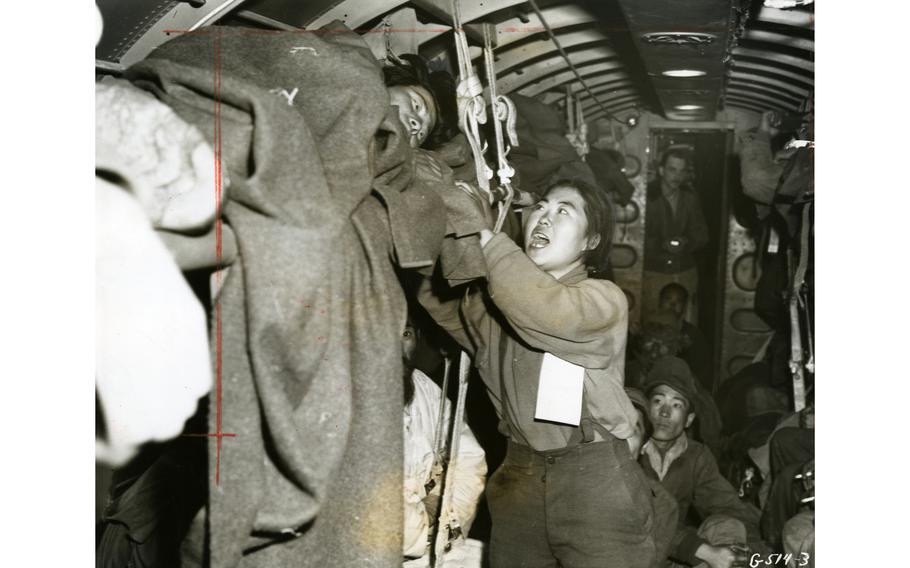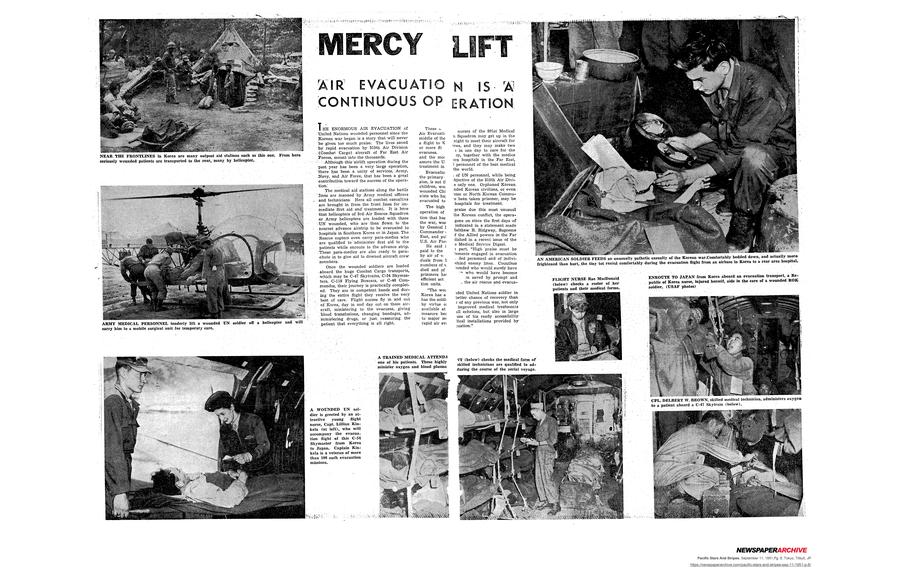
The original caption of this image — captured by an unknown U.S. Air Force photographer and published in the Pacific Stars and Stripes, Sept. 11, 1951 — read “En route to Japan from Korea aboard an evacuation transport, a Republic of Korea nurse, injured herself, aids in the care of a wounded ROK soldier.” Although the article ran with a number of images, this image is the only known image to have survived in Stars and Stripes’ Pacific archives. (U.S. Air Force)
This article first appeared in the Stars and Stripes Pacific edition, Sept. 11, 1951. It is republished unedited in its original form.
The enormous air evacuation of United Nations wounded personnel since the Korean war began is a story that will never be given too much praise. The lives saved by rapid evacuation by 315th Air Division (Combat Cargo) aircraft of Far East Air Forces, mount into the thousands.
Although this airlift operation during the past year has been a very large operation, there has been a unity of services, Army, Navy, and Air Force, that has been a great contribution toward the success of the operation.
The medical aid stations along the battle lines are manned by Army medical officers and technicians. Here all combat casualties are brought in from the front lines for immediate first aid and treatment. It is here that helicopters of the 3rd Air Rescue Squadron or Army helicopters are loaded with these UN wounded, who are then flown to the nearest advance airstrip to be evacuated to hospitals in Southern Korea or in Japan. The Rescue copters even carry para-medics who are qualified to administer first aid to the patients while enroute to the advance strip. These para-medics are also ready to parachute in to give aid to downed aircraft crew members.
Once the wounded soldiers are loaded aboard the huge Combat Cargo transports, which may be C-47 Skytrains, C-54 Skymasters, C-119 Flying Boxcars, or C-46 Commandos, their journey is practically completed. They are in competent hands and during the entire flight they receive the very best of care. Flight nurses fly in and out of Korea, day in day out on these aircraft, ministering to the evacuees, giving blood transfusions, changing bandages, administering drugs, or just reassuring the patient that everything is all right.
These nurses of the 801st Medical Air Evacuation Squadron may get up in the middle of the night to meet their aircraft for a flight to Korea and they may make two or more flights in one day to care for the evacuees. They, together with the medics and the most modern hospitals in the Far East, assure the UN personnel of the best medical treatment in the world.
Evacuation of UN personnel, while being the primary objective of the 315th Air Division, is not the only one. Orphaned Korean children, wounded Korean civilians, or even wounded Chinese or North Korean Communists who have been taken prisoner, may be evacuated to hospitals for treatment.
The high praise due this most unusual operation of the Korean conflict, the operation that has gone on since the first days of the war, was indicated in a statement made by General Matthew B. Ridgeway, Supreme Commander of the Allied powers in the Far East, and published in a recent issue of the U.S. Air Force Medical Service Digest.
He said in part, “High praise must be paid to the elements engaged in evacuation by air of wounded personnel and of individuals from behind enemy lines. Countless numbers of wounded who would surely have died and of those who would have become prisoner have been saved by prompt and efficient actions by the air rescue and air evacuation units.”
“The wounded United Nations soldier in Korea has a better chance of recovery than has the soldier of any previous war, not only by virtue of improved medical treatments available at all echelons, but also in large measure because of his ready accessibility to major medical installations provided by rapid air evacuation.”
Looking for Stars and Stripes’ coverage of the Korean War? Subscribe to Stars and Stripes’ historic newspaper archive! We have digitized our 1948-1999 European and Pacific editions, as well as several of our WWII editions and made them available online through https://starsandstripes.newspaperarchive.com/

The original article ran with eight images, presumably all by military photographers not assigned to Stars and Stripes Pacific’s Korea bureau. Only one of the images has been found in our Pacific archives at this time. (Stars and Stripes)